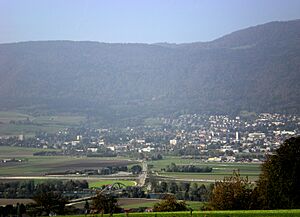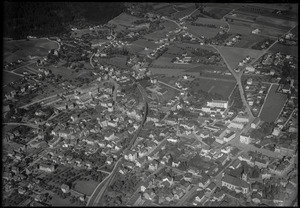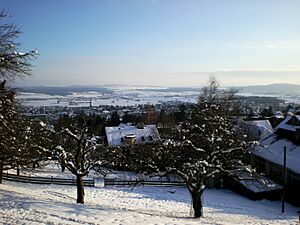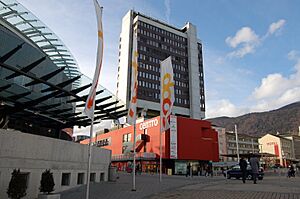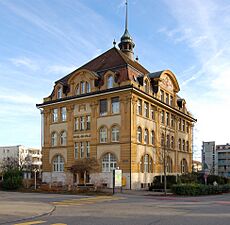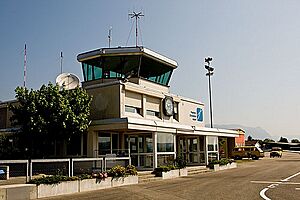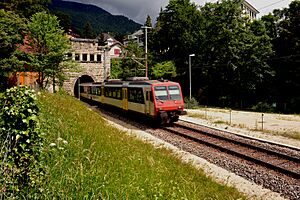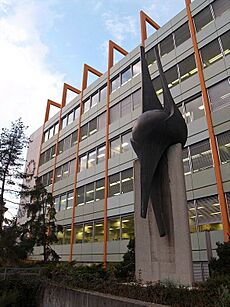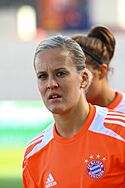Grenchen facts for kids
Quick facts for kids
Grenchen
|
||
|---|---|---|
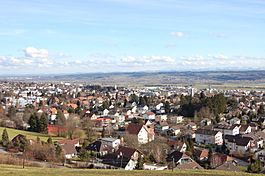
Grenchen
|
||
|
||
| Country | Switzerland | |
| Canton | Solothurn | |
| District | Lebern | |
| Area | ||
| • Total | 26.03 km2 (10.05 sq mi) | |
| Elevation | 451 m (1,480 ft) | |
| Population
(Dec 2020 )
|
||
| • Total | 17,577 | |
| • Density | 675.26/km2 (1,748.9/sq mi) | |
| Postal code |
2540
|
|
| Surrounded by | Arch (BE), Bettlach, Büren an der Aare (BE), Court (BE), Lengnau (BE), Romont (BE), Rüti bei Büren (BE), Selzach | |
| Twin towns | Neckarsulm (Germany), Sélestat (France) | |
Grenchen (which is called Granges in French) is a town in Switzerland. It's located in the canton of Solothurn, in the Lebern district.
This town sits at the bottom of the Jura mountains, between the cities of Solothurn and Biel/Bienne. It's about 25 kilometers (15.5 miles) north of Bern, the capital of Switzerland. Grenchen is one of the bigger towns in Solothurn, with over 16,000 people living there. It's especially famous for its watch industry, which has been making watches for more than 150 years!
In 2008, Grenchen won the Wakker Prize. This award is given to places that do a great job of protecting their old buildings and history. You can also find the Jura-Sternwarte Grenchen observatory here, where people study the stars.
Contents
History of Grenchen
Around 1000 AD, local leaders built a castle on a nearby cliff. People lived in this castle for about 300 years. The name Grenchen was first written down in 1131 as Granechun. The name likely comes from an old word meaning "by the granary," which was a place to store grain.
Key Dates in Grenchen's Past
- 1851: The town started making clocks. This was the beginning of its famous watch industry.
- 1918: A big general strike happened in Switzerland, and Grenchen was part of it.
Geography and Nature
Grenchen covers an area of about 26 square kilometers (10 square miles). A large part of this land, about 38%, is used for farming. Even more, about 40%, is covered by forests. The rest of the land is where buildings and roads are (about 20.7%), or it's rivers and lakes (about 1.3%).
The town is the main center of the Lebern District and the second-largest city in the Solothurn canton. Grenchen stretches from a small village called Staad, located by the Aare river at 430 meters (1,410 feet) above sea level, all the way up to the first mountain range of the Jura Mountains, called Oberer Grenchenberg, which is 1,348 meters (4,423 feet) high.
Town Symbols: Coat of Arms
The official symbol, or blazon, of Grenchen's coat of arms is simple: it shows a silver plow blade on a red background.
People and Population
Grenchen has a population of over 17,000 people. About 28.7% of the people living here are from other countries.
Most people in Grenchen speak German, which is about 81.8% of the population. The next most common languages are Italian (6.4%) and French (2.9%).
Many people who live in Grenchen were also born there, about 35.2%. Others were born in the same canton, or in other parts of Switzerland, or even outside of Switzerland.
The age groups in Grenchen are spread out. About 5.9% of the population are young children (0-6 years old), and 14.4% are teenagers (7-19 years old). The largest group, about 28%, are adults between 25 and 44 years old. There are also many older adults and seniors.
The historical population of Grenchen has changed over time, as you can see in this chart:

Places to See
The whole village of Grenchen is considered an important heritage site in Switzerland. This means its buildings and areas are protected because of their historical value. You can also visit the ruins of Burg Grenchen, an old hill castle that was once called Bettleschloss.
Getting Around: Transport
Even though Grenchen is not a huge city, it has its own airport, Grenchen Airfield. This airport is mainly used by private pilots and people who like parachuting. It's also used for business trips. The A5 freeway, a major road, is close to the airport.
Grenchen also has two train stations:
- Grenchen Nord is on the train line that goes between Basel and Biel.
- Grenchen Süd is on the line connecting Geneva and Zürich.
These stations give the city great connections to the national train network. There's also the Grenchen Tunnel, a long railroad tunnel (8.5 km or 5.3 miles) built between 1911 and 1915. This tunnel connects the Swiss plateau to Delémont and Basel. Many foreign workers, especially from Italy, came to Grenchen to help build this tunnel.
The town has its own bus company, "BGU." These bus lines connect Grenchen to nearby towns like Bettlach, Lengnau, Büren, Rüti, and Selzach.
Economy and Jobs
Grenchen has a mix of jobs. About 38% of jobs are in the secondary sector, which includes manufacturing and construction. The tertiary sector, which covers services like sales, transportation, hotels, healthcare, and education, makes up about 42% of jobs.
Many people who work in Grenchen travel there from other towns. For every person who leaves Grenchen for work, about 1.6 people come into the town to work. Most people get to work by private car (52.8%), while others use public transportation (13.8%).
The Famous Watch Industry
Grenchen is very well known for its long history in the watch industry. Several famous watch companies have their main offices or factories in the city. These include:
- Atlantic Watch Production Ltd
- Breitling SA
- Epos
- ETA SA
- Fortis
- Eterna SA
- Nivada
- Titoni Ltd.
Sports in Grenchen
FC Grenchen is the town's football (soccer) club.
Grenchen is also home to a special indoor cycling track called Velodrome Suisse. This velodrome hosted the 2015 UEC European Track Championships, where a new world record was set in the Ladies' 500m Time Trials!
Religion in Grenchen
Based on information from 2000, many people in Grenchen are either Roman Catholic (about 35.5%) or belong to the Swiss Reformed Church (about 36.1%). There are also people who follow other Christian churches, Islam, Buddhism, and Hinduism. Some people do not belong to any church.
Education and Learning
In Grenchen, many people have completed higher levels of education. About 36.2% of the population have finished non-mandatory upper secondary education, and 9.1% have gone on to higher education at a university or a specialized college.
The school system in Solothurn canton allows young children to attend two years of non-required Kindergarten. After that, students go to six years of primary school. Then, they have three years of required secondary school, followed by optional advanced schools.
Grenchen has its own public library, the Stadtbibliothek Grenchen. In 2008, the library had 36,000 books and other items, and it loaned out 57,000 items that year. It was open for 258 days, averaging 19 hours per week.
Famous People from Grenchen
Many interesting people have connections to Grenchen:
- Franz Joseph Hugi (1791–1855), a priest, geologist, and mountain climber, was born here.
- Giuseppe Mazzini (1805–1872), an important leader for Italy's independence, lived in Grenchen for a time (1835-1836).
- Hermann Obrecht (1882–1940), a Swiss government official.
- Yehudi Menuhin (1916–1999), a world-famous conductor and violinist, was made an honorary citizen of Grenchen.
- Ernst Thomke (born 1939), who helped invent the famous Swatch watch.
- Boris Banga (born 1949), who was the Mayor of Grenchen for many years.
- Ruth Lüthi (born 1947), a politician and academic.
- Alain Auderset (born 1968), an author of Christian comic books.
Sports Stars
- Serge Muhmenthaler (born 1953), a retired football player and referee.
- Ronnie Durrenmatt (born 1979), a slalom canoeist who competed in the 2004 Summer Olympics.
- Silvan Aegerter (born 1980), a footballer with over 280 club games.
- Marco Wölfli (born 1982), a footballer with over 360 club games.
- Vanessa Bürki (born 1986), a Swiss female footballer who played many games for the Switzerland women's national football team. She was named Swiss female footballer of the year in 2006.
- Haris Tabaković (born 1994), a Swiss footballer.
See also
 In Spanish: Grenchen para niños
In Spanish: Grenchen para niños





